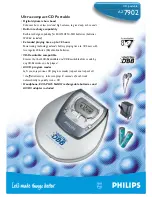
(8) Dual Watch Operation (TDR) - MENU No. 7
When this function is activated, you can receive the frequency of channel A and channel B at the same time.
If a signal is detected, the
▼
/
▲
pointer
will blink on the corresponding channel or frequency.
Note: In Dual Watch operation mode, you can change the parameter of AB channel or frequency freely.
(9) Keypad beep (BEEP) - MENU No. 8
When this function is enabled, every time a button is pressed, you will hear a beep tone.
(10) Time-Out-Timer (TOT) - MENU No.9
The TOT function is used to prevent a too long transmission and limits the tx time: TOT temporarily stops the
transmission if the radio has been used beyond the max pre-set time (for example 15s, 30s, 45s, etc).
(11) Receiving DCS (R-DCS) - MENU No.10
DCS codes are similar to access codes and can be added to channels, so as to create a sort of personal channel.
They enable the radio to communicate with the users that are tuned on the same channel and have set the same
DCS code.
You can choose amongst:
•
OFF:
OFF
•
R-DCS:
D023N-D754N (Normal DCS)
•
R-DCS:
D023I-D754I (Inverse DCS)
Note: In UV-5G there are 208 groups of normal and inverse DCS codes. This function cannot be amended in
channel mode.
(12) Receiving CTCSS (R-CTCSS) - MENU No.11
As DCS codes, the CTCSS codes can be added to the channels for creating new private channels.
Note: there are 50 groups of CTCSS tones. In channel mode the CTCSS tones cannot be changed.
(13) Transmitting DCS - (T-DCS) - MENU No.12
In this Menu you activate DCS codes in tx mode. You can choose between normal R-DCS (D023N-D754N) and
inverted R-DCS (D023I-D754I)
Note: the groups of DCS codes are 208. DCS codes cannot be changed in channel mode.
(14) Transmitting CTCSS (T-CTCSS) - MENU No.13
In this Menu you can set a CTCSS tone in tx mode.
You can choose: OFF or CTCSS (67.0 to 254.1 Hz)
Note: there are 50 groups of CTCSS tones. In channel mode the CTCSS tones cannot be changed.
(15) Voice function (VOICE) - MENU No. 14
With this function, you activate a voice that informs you about any operation/ selection you are doing.
(16) ANI-ID (ANI-ID) - MENU No.15
With this function you can set your ID-code. It can be programmed by the proper programming software. You can
edit up to 5 digits.
(17) DTMFST (DTMFST) - MENU No.16
Determines when DTMF Side Tones can be heard from the transceiver speaker.
(18) Signal code (S-CODE) - MENU No.17
Selects 1 of 15 DTMF codes. The DTMF codes are programmed with software and are up to 5 digits














































